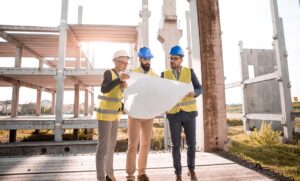
The Effect Construction Projects Can Have On The Environment And How To Reduce It
Construction projects can significantly impact the environment through resource consumption, pollution, and habitat disruption. To mitigate these effects, adopting sustainable practices is vital.
In the following post, we’ll help you learn more about the effects that construction projects can have on their surrounding environments and the health of the planet. We’ll also be listing some useful tips to help reduce these effects and create a more sustainable building project.
Damage To The Ground From Machinery
Minimizing ground damage during building projects is crucial. Start with careful site selection and assessment to avoid sensitive areas. Utilize protective measures like timber mats to distribute weight and prevent compaction. Implement proper erosion control methods to prevent soil loss.
Use well-defined pathways for machinery and equipment to reduce soil disturbance. Employ sustainable construction practices that prioritize soil preservation, ensuring long-term ecological health and minimizing the project’s environmental impact.
Reducing Noise Pollution
Mitigating noise pollution during building projects is essential. Schedule noisy tasks during daytime hours and avoid them during quiet times. Use noise barriers and acoustic enclosures to contain sound. Employ modern equipment designed for quieter operations.
Inform nearby residents about the construction timeline and potential noise levels. Regularly monitor noise emissions to ensure compliance with regulations. By adopting these measures, you can minimize disturbances, maintain community harmony, and uphold environmental standards throughout the project’s lifecycle.
Avoiding Destroying Habitats
Safeguarding wildlife habitats during building projects is imperative. Begin with comprehensive site assessments to identify ecologically sensitive areas. Tailor project designs to steer clear of vital habitats. Introduce buffer zones to shield wildlife from disturbances.
Plan construction schedules that respect nesting and breeding seasons, reducing impact. Utilize temporary barriers to prevent animals from accessing hazardous zones. Educate personnel about wildlife protocols and emergency responses.
Using Sustainable Materials
Incorporating sustainable materials into building projects is essential. Choose eco-friendly options like reclaimed wood, recycled metals, and low-impact concrete. Opt for locally sourced materials to reduce transportation emissions. Prioritize products with minimal energy-intensive production processes.
Consider renewable materials like bamboo and straw for various applications. Select materials with high durability to extend the building’s lifecycle. Embrace innovative alternatives such as green insulation and photovoltaic glass.
Seeking Professional Advice
Seeking professional advice for environmentally friendly construction is essential. Engaging with architects, engineers, and sustainability consultants can provide insights into green design, renewable energy integration, efficient material choices, and waste reduction strategies. Their expertise ensures your project aligns with eco-conscious principles, minimizing its ecological footprint and contributing to a more sustainable built environment.
Reduce Transportation
Minimizing transportation in construction is key. Opt for local suppliers to reduce distances for material delivery. Centralize equipment storage to decrease travel to and from sites. Implement digital tools for remote communication, reducing the need for on-site meetings. By cutting transportation, you lower emissions, conserve energy, and enhance project efficiency, while contributing to a greener construction process.
Building For Long-Term Sustainability
Building for long-term sustainability in construction involves designing structures with durability, energy efficiency, and adaptability. Use high-quality materials, efficient insulation, and renewable energy systems. Plan for future needs, allowing easy updates and modifications.
By prioritizing these aspects, you create buildings that stand the test of time, minimize resource consumption, and ensure a lasting positive impact on the environment and occupants.